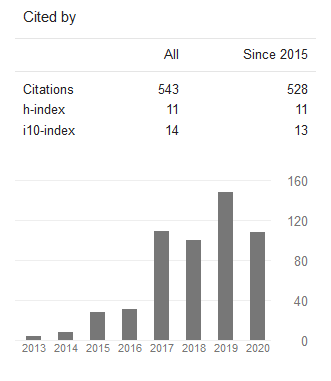Comparative Analysis of Sound Response from Simple and Fuzzy Algorithm in Saron Virtual Reality
DOI:
https://doi.org/10.24002/jbi.v14i01.6612Keywords:
suara, gamelan, Saron, dinamika, fuzzy, sound, gamelan, Saron, dynamics, fuzzyAbstract
Virtual reality games with musical instruments require a dynamic sound response because playing the instrument requires real human feelings. A good sound in a game depends on its suitability for the game situation. Time and place limitations are a problem in recording variations in sound sample recording. If the sound samples taken are limited and a simple algorithm is applied, it may sound repetitive and not match the dynamics of music according to real human life. Therefore, in this study, a comparison of a simple algorithm with the fuzzy algorithm was carried out in the Gamelan Saron game. The data processing method used is a comparative analysis obtained from the experimental results of the respondents. On the agreement scale of one to five, most respondents agree that there is a better significant change after being given a fuzzy algorithm described by a mean value of 4.1.
Keywords: sound, gamelan, Saron, dynamics, fuzzy
References
D. Hong, H. Kwon, C. G. Kim, and W. Park, “Real-time 3D Audio Downmixing System based on Sound Rendering for the Immersive Sound of Mobile Virtual Reality Applications,” vol. 12, no. 12, pp. 5936–5954, 2018.
M. Wolf, P. Trentsios, N. Kubatzki, C. Urbanietz, and G. Enzner, “Implementing Continuous-Azimuth Binaural Sound in Unity 3D,” Proc. - 2020 IEEE Conf. Virtual Real. 3D User Interfaces, VRW 2020, pp. 384–389, 2020, doi: 10.1109/VRW50115.2020.00083.
S. Aleem, L. F. Capretz, and F. Ahmed, “Game development software engineering process life cycle: a systematic review,” J. Softw. Eng. Res. Dev., vol. 4, no. 1, 2016, doi: 10.1186/s40411-016-0032-7.
B. L. Ludlow, “Virtual Reality: Emerging Applications and Future Directions,” Rural Spec. Educ. Q., vol. 34, no. 3, pp. 3–10, 2015, doi: 10.1177/875687051503400302.
J. E. Halim, A. Rusli, and S. Hansun, “Beat defender: Integrating fuzzy logic into audio visualization video game,” Int. J. Eng. Res. Technol., vol. 12, no. 6, pp. 753–759, 2019.
H. Kuswanto, “Saron Demung ’ S Timbre and Sonogram of Gamelans Gunturmadu From Keraton Ngayogyakarta,” J. Pendidik. Fis. Indones. (Indonesian J. Phys. Educ., vol. 8, no. 1, pp. 90–97, 2012, [Online]. Available: http://journal.unnes.ac.id/nju/index.php/JPFI.
K. S. A., “Pemanfaatan Saron Sanga Laras Slendro Gamelan Jawa Sebagai Media Pembelajaran Fisika SMA Materi Gelombang Bunyi,” Sci. J. Inov. Pendidik. Mat. dan IPA, vol. 2, no. 2, 2022.
F. Ariani and R. Y. Endra, “Implementation Of Fuzzy Inference System With Tsukamoto Method For Study Programme Selection,” 2nd Int. Conf. Eng. Technol. Dev., no. Icetd, pp. 189–200, 2013, [Online]. Available: http://artikel.ubl.ac.id/index.php/icetd/article/view/144.
Y. A. Gerhana, W. B. Zulfikar, Y. Nurrokhman, C. Slamet, and M. A. Ramdhani, “Decision support system for football player’s position with tsukamoto fuzzy inference system,” MATEC Web Conf., vol. 197, pp. 1–6, 2018, doi: 10.1051/matecconf/201819703014.
B. A. Ojokoh, M. O. Omisore, O. W. Samuel, and T. O. Ogunniyi, “A Fuzzy Logic Based Personalized Recommender System,” Int. J. Comput. Sci. Inf. Technol. Secur., vol. 2, no. 5, pp. 1008–1015, 2012.
R. N. Raj and K. Shankar, “Multi-objective Goal Programming for Low Altitude Seat Ejections with Fuzzy Logic–Based Decision-making,” Hum. Factors Mech. Eng. Def. Saf., vol. 4, no. 1, 2020, doi: 10.1007/s41314-019-0031-7.
S. Baskar, G. Sriram, and S. Arumugam, “Fuzzy logic model to predict oil-film pressure in a hydrodynamic journal bearing lubricated under the influence of nano-based bio-lubricants,” Energy Sources, Part A Recover. Util. Environ. Eff., vol. 40, no. 13, pp. 1583–1590, 2018, doi: 10.1080/15567036.2018.1486479.
H. Agung and C. C. Alsher, “Implementasi Algoritma Fuzzy Tsukamoto Pada Prototype Regulator Suhu Kandang Kelinci,” JATISI (Jurnal Tek. Inform. dan Sist. Informasi), vol. 5, no. 1, pp. 1–11, 2018, doi: 10.35957/jatisi.v5i1.128.
G. S. Mada, N. K. F. Dethan, and A. E. S. H. Maharani, “The Defuzzification Methods Comparison of Mamdani Fuzzy Inference System in Predicting Tofu Production,” J. Varian, vol. 5, no. 2, pp. 137–148, 2022, doi: 10.30812/varian.v5i2.1816.
M. Wacker, “Unity-VRInputModule,” GitHub, 2017. https://github.com/wacki/UnityVRInputModule/blob/master/Assets/SteamVR/InteractionSystem/Core/Scripts/VelocityEstimator.cs.
Downloads
Published
Issue
Section
License

This work is licensed under a Creative Commons Attribution-ShareAlike 4.0 International License.
Copyright of this journal is assigned to Jurnal Buana Informatika as the journal publisher by the knowledge of author, whilst the moral right of the publication belongs to author. Every printed and electronic publications are open access for educational purposes, research, and library. The editorial board is not responsible for copyright violation to the other than them aims mentioned before. The reproduction of any part of this journal (printed or online) will be allowed only with a written permission from Jurnal Buana Informatika.
This work is licensed under a Creative Commons Attribution-ShareAlike 4.0 International License.










